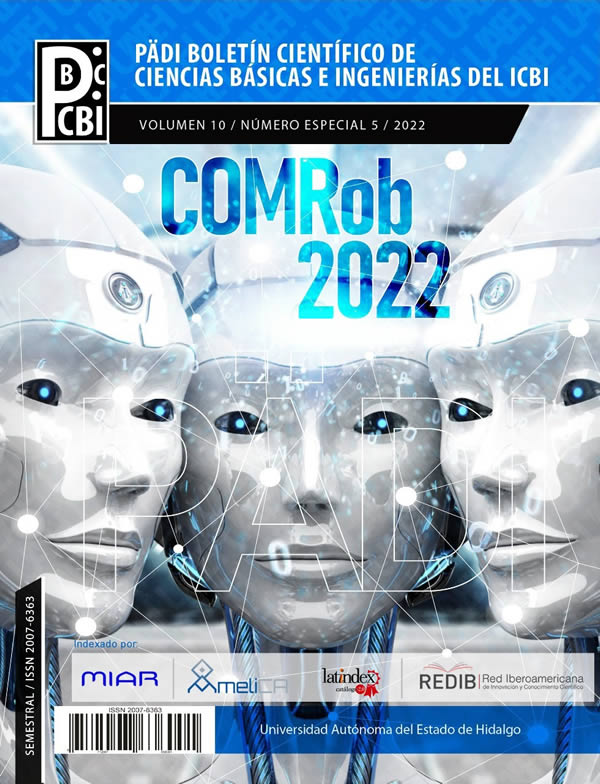Estudio comparativo de controladores PID WaveNet-IIR aplicado a un helicóptero de 2 GDL
DOI:
https://doi.org/10.29057/icbi.v10iEspecial5.10067Palabras clave:
Controladores inteligentes, Identificación para control, Control adaptativo lineal, Control adaptativo por redes neuronalesResumen
En aplicaciones de control inteligente, uno de los problemas es determinar el número de capas y de neuronas en cada capa. Esto se vuelve más complejo con ciertos tipos de redes neuronales como las basadas en wavelets donde las traslaciones y dilataciones son parámetros adicionales. Este artículo presenta un estudio comparativo para determinar el tipo de wavelet y número de neuronas que muestran el mejor desempeño para controlar un helicóptero Quanser de dos grados de libertad (GDL). Se presenta un controlador tipo PID-WaveNet-IIR el cuál se compone de controladores PID discretos en el tiempo, con ganancias auto-sintonizables por una red neuronal de base radial cuyas funciones de activación son wavelets y un par de filtros de respuesta de impulso infinito (IIR) para ``podar'' algunas neuronas. Por medio de simulaciones numéricas, usando LabVIEW, se presenta el desempeño del sistema en lazo cerrado para: diferentes condiciones de operación, tipos de familia wavelets donde se fijan valores mínimos de los errores de seguimiento, tipo de wavelet, el número de neuronas de la red y número de coeficientes de adelanto y atraso de los filtros IIR.
Descargas
Información de Publicación
Perfiles de revisores N/D
Declaraciones del autor
Indexado en
- Sociedad académica
- N/D
Citas
Abuhamdia, T. y Taheri, S. (2017). Wavelets as a tool for systems analysis and control. Journal of Vibration and Control, 23:1377 – 1416.
Åström, K. (1995). PID Controllers. Instrument Society of America.
Åström, K. (1996). Advanced PID control. Instrument Society of America.
Barron-Gómez, R., Ramos-Velasco, L. E., Espinoza-Quesada, E., y GarcíaCarrillo, L. (2017). Wavelet neural network pid controller for a uas transporting a cable-suspended load. 20th World Congress, IFAC, pp. 2371–2376.
Carrillo-Santos, C., Seck-Tuoh-Mora, J., Hernandez-Romero, N., y Ramos-Velasco, L. (2018). Wavenet identification of dynamical systems by a modified PSO algorithm. Eng Appl Artif Intell, 79:1–9.
Deisenroth, M., Faisal, A., y Ong, C. (2020). Mathematics for machine learning. Cambrige University Press.
Domínguez-Mayorga, C. R., Espejel-Rivera, M., Ramos-Velasco, L. E.,
Ramos-Fernandez, J., y Escamilla Hernádez, E. (2012). Wavenet algorithms with applications in approximation signals: a comparative study. RIAI, 9:347–358.
Garcia-Castro, O. F. (2020). Controladores PID wavenet aplicados a un modelo de helicoptero de 2 GDL. Ge, S. S. y Wang, C. (2002). Direct adaptive nn control of a class of nonlinear systems. IEEE Trans Neural Netw, 13(1):214–221.
Haykin, S. (1999). Neural networks: a comprehensive foundation. Pearson Eduaction Inc, EUA.
Huang, S., Tan, K. K., y Lee, T. H. (2002). Adaptive motion control using neural network approximations. Automatica, 38(2):227–233.
Huang, S., Tan, K. K., y Putra, A. S. (2007). Adaptive control of mechanical systems using neural networks. IEEE Trans Syst Man, 37(5):897–903.
Inc., Q. (2012). User manual 2 DOF helicopter experiment, set up and configuration. Markham, Ontario.
Li, Y., Qiang, S., Zhuang, X., y Kaynak, O. (2004). Robust and adaptive backstepping control for nonlinear systems using RBF neural networks. IEEE Trans Neural Netw, 14(3):693–701.
Mallat, S. (2009). A wavelet tour of signal processing. Elsevier.
Ogata, K. (1996). Sistemas de control en tiempo discreto. Prentice Hall.
Ramos-Velasco, L. E., Domínguez-Ramírez, O., y Parra-Vega, V. (2016). Wavenet fuzzy PID controller for nonlinear mimo systems: experimental validation on a high-end haptic robotic interface. Applied Soft Computing, pp.199–205.
Sanner, R. M. y Slotine, J. E. (1992). Gaussian networks for direct adaptive control. IEEE Trans Neural Netw, 3(6):837–863.
Seshagiri, S. y Khalil, H. K. (2000). Output feedback control of nonlinear systems using RBF networks. IEEE Trans Neural Netw, 11(1):69–79.
Sundararajan, N., Saratchandran, P., y Li, Y. (2002). Fully tuned radial basis function neural networks for flight control. Kluwer, Boston.
Tangirala, A. K., Mukhopadhyay, S., y Tiwari, A. P. (2013). Chapter three - wavelets applications in modeling and control. Control and Optimisation of Process Systems, 43:107–204.
Vega-Navarrete, M. A., Ramos-Velasco, L. E., Arizpe-Carreon, P. A., Delgado-Romero, V., Valle-Hernandez, J., y Parra-Vega, V. (2018). Output feedback self-tuning wavenet control for underactuated euler-lagrange systems. The 2nd IFAC Conference on Modelling (MICNON 2018), pp. 663–668.
Wang, S. W. y Yu, D. L. (2007). Adaptive RBF network for parameter estimation and stable air–fuel ratio control. Neural Netw, 21(1):102–112.
Zhu, Q., Fei, S., Zhang, T., y Li, T. (2008). Adaptive RBF neural-networks control for a class of timedelay nonlinear systems. Neural Netw, 71(16–18):3617–3624.




















